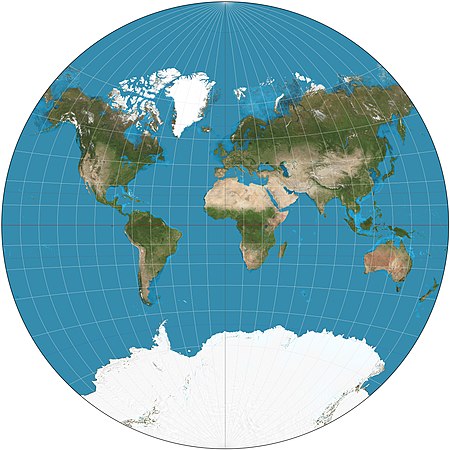| Revision as of 13:29, 13 May 2011 editMystBot (talk | contribs)177,678 editsm r2.7.1) (robot Adding: de:Van-der-Grinten-Projektion← Previous edit | Revision as of 01:02, 16 August 2011 edit undoStrebe (talk | contribs)Extended confirmed users8,436 edits Replace low-contrast imagesNext edit → | ||
| Line 1: | Line 1: | ||
| ]]] | ]] | ||
| The '''van der Grinten projection''' is neither ] nor ]. It projects the entire Earth into a circle, though the polar regions are subject to extreme distortion. The projection was the first of four proposed by Alphons J. van der Grinten in 1904, and, unlike most projections, is an arbitrary geometric construction on the plane. It was made famous when the ] adopted it as their reference map of the world from 1922 until 1988<ref>''Flattening the Earth: Two Thousand Years of Map Projections'', John P. Snyder, 1993, pp.258-262, ISBN 0-226-76747-7.</ref>. | The '''van der Grinten projection''' is neither ] nor ]. It projects the entire Earth into a circle, though the polar regions are subject to extreme distortion. The projection was the first of four proposed by Alphons J. van der Grinten in 1904, and, unlike most projections, is an arbitrary geometric construction on the plane. It was made famous when the ] adopted it as their reference map of the world from 1922 until 1988<ref>''Flattening the Earth: Two Thousand Years of Map Projections'', John P. Snyder, 1993, pp.258-262, ISBN 0-226-76747-7.</ref>. | ||
Revision as of 01:02, 16 August 2011

]
The van der Grinten projection is neither equal-area nor conformal. It projects the entire Earth into a circle, though the polar regions are subject to extreme distortion. The projection was the first of four proposed by Alphons J. van der Grinten in 1904, and, unlike most projections, is an arbitrary geometric construction on the plane. It was made famous when the National Geographic Society adopted it as their reference map of the world from 1922 until 1988.
The geometric construction given by van der Grinten can be written algebraically:
where takes the sign of , takes the sign of and
Should it occur that , then
Similarly, if or , then
In all cases, is the latitude, is the longitude, and is the central meridian of the projection.
Notes
- Flattening the Earth: Two Thousand Years of Map Projections, John P. Snyder, 1993, pp.258-262, ISBN 0-226-76747-7.
- Map Projections - A Working Manual, USGS Professional Paper 1395, John P. Snyder, 1987, pp.239-242
References
This cartography or mapping term article is a stub. You can help Misplaced Pages by expanding it. |


 takes the sign of
takes the sign of  ,
,  takes the sign of
takes the sign of  and
and





 , then
, then


 or
or  , then
, then


 is the longitude, and
is the longitude, and  is the central meridian of the projection.
is the central meridian of the projection.